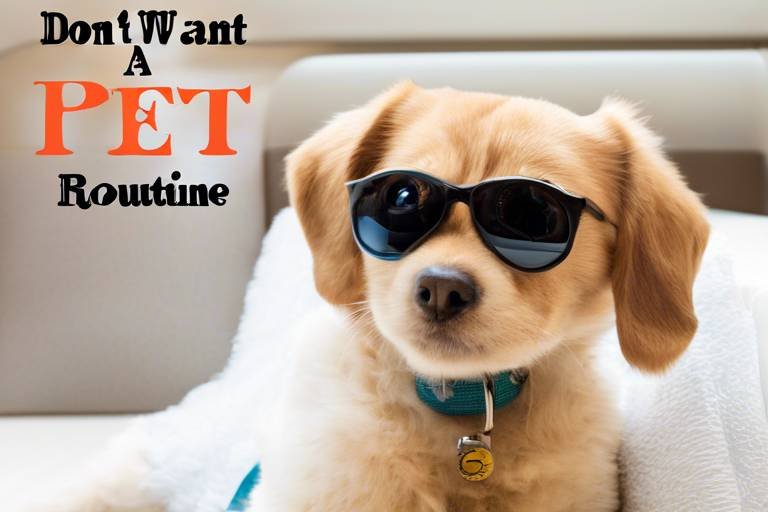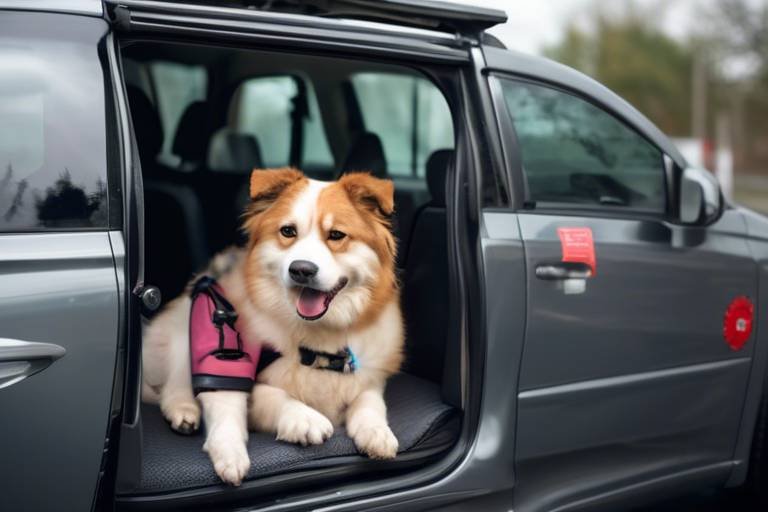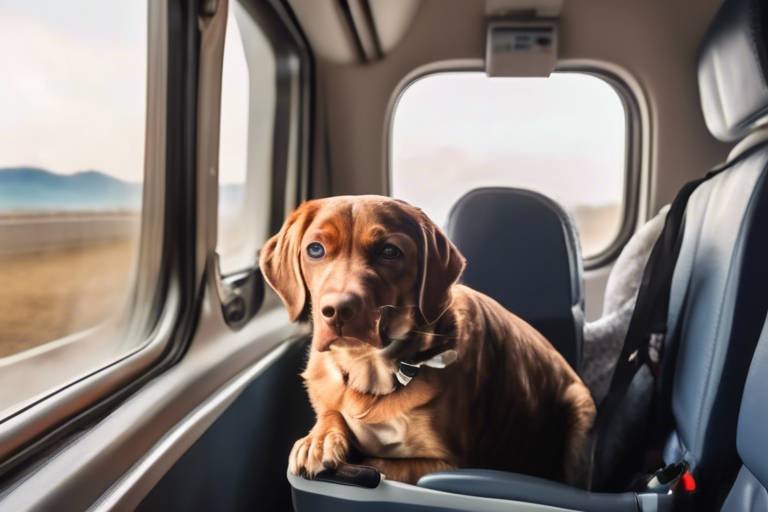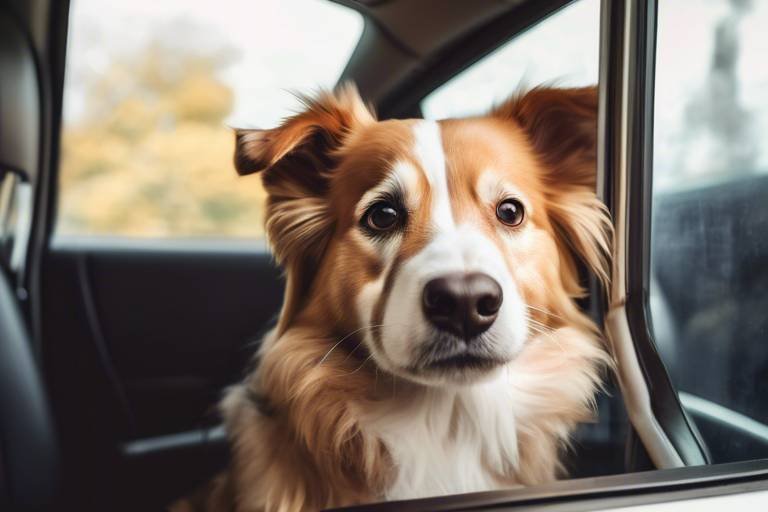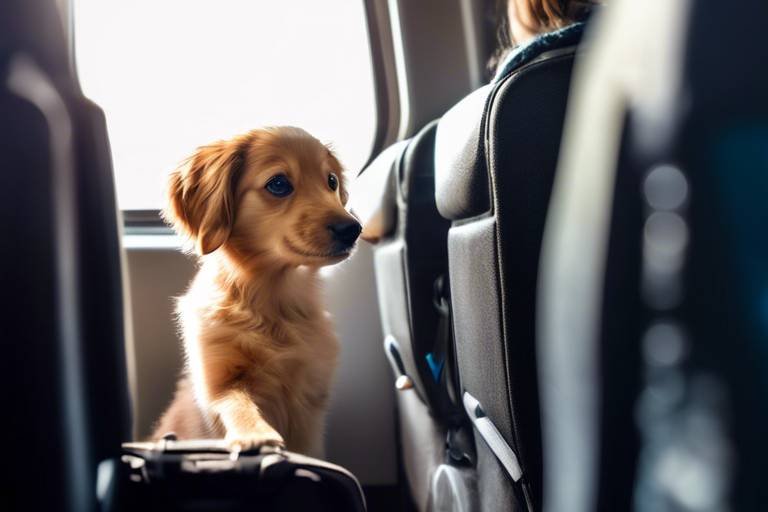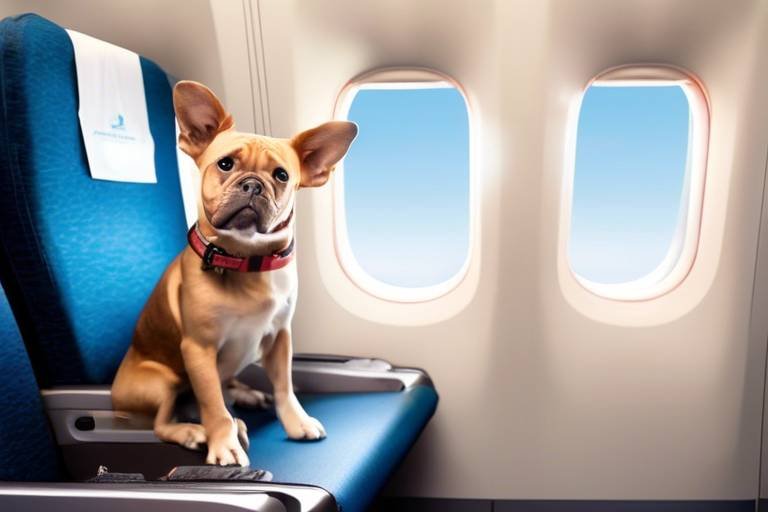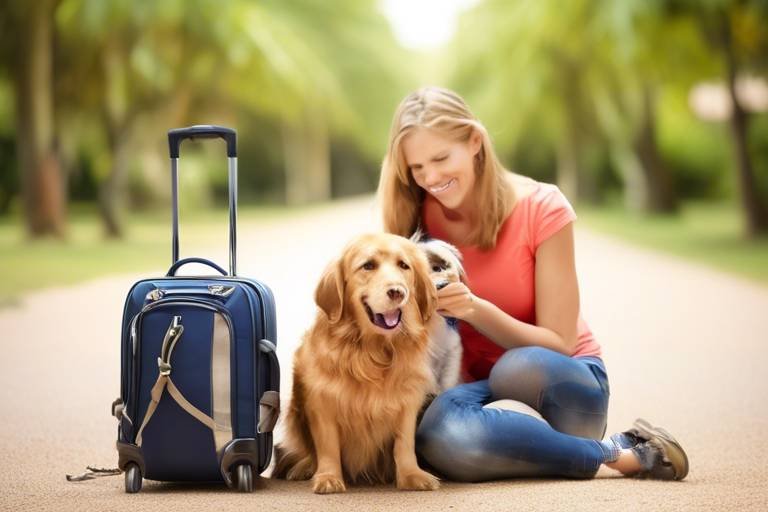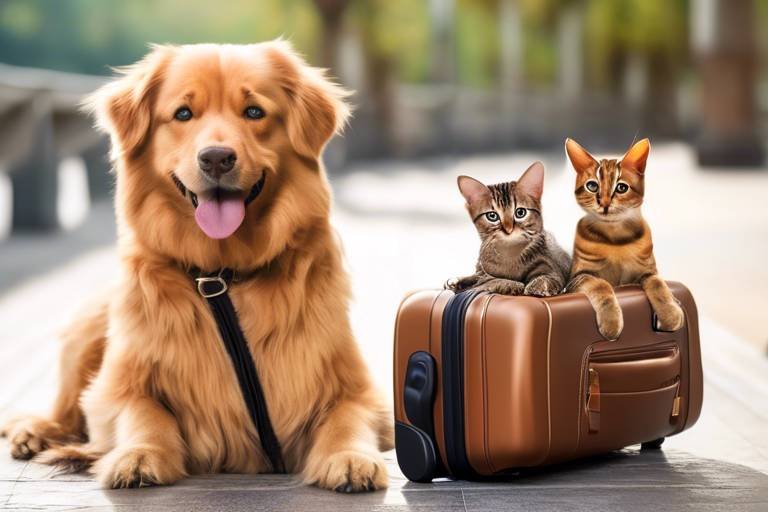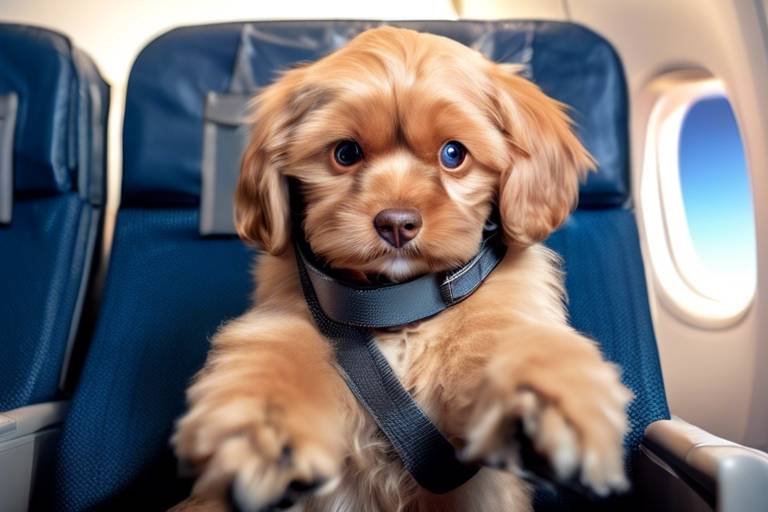How to Create a Pet Travel Routine
Traveling with your furry friends can be one of the most rewarding experiences, but it also requires careful planning and consideration. Establishing a pet travel routine is essential to ensure that your pets are comfortable and safe during your journeys. Just like humans, pets thrive on routine, and having a structured approach to travel can significantly reduce their anxiety. Imagine taking a road trip without any snacks or bathroom breaks—chaos, right? The same applies to your pets! By understanding their needs and preparing adequately, you can turn a potentially stressful situation into a delightful adventure.
Before you hit the road or board a plane, it's crucial to take a step back and assess your pet's unique requirements. Every pet is different; some may be seasoned travelers, while others might be nervous at the thought of leaving home. Recognizing your pet’s temperament, health status, and preferences will help you tailor your travel routine to fit their needs. For instance, if your dog is prone to motion sickness, you might want to consider a few remedies or even consult your vet before the trip. On the other hand, if your cat loves to explore, you might need to plan for extra playtime during your travels.
Once you understand your pet's needs, the next step is to prepare for travel. This involves not just packing your bags but also gathering essential items for your pet. Think about their favorite blanket, toys, food, and water bowls. You wouldn't want to forget their essentials, right? Moreover, ensuring that your pet is healthy and up-to-date on vaccinations is vital. A quick trip to the vet can provide peace of mind and make sure your pet is ready for the adventure ahead.
In the upcoming sections, we will delve deeper into the nitty-gritty of creating a successful travel routine. From choosing the right carrier and understanding health considerations to making car rides enjoyable and safe, we’ve got you covered. So buckle up, because we’re about to embark on a journey to ensure that both you and your pet have a fantastic travel experience!
- What should I pack for my pet when traveling? Be sure to bring food, water, bowls, a leash, waste bags, medications, and familiar items like toys or blankets.
- How can I help my pet adjust to traveling? Gradually acclimate them to their carrier or travel space, and try short trips before longer journeys.
- Are there specific health checks I should do before traveling? Yes, ensure vaccinations are up-to-date and consult your vet about any health concerns related to travel.
- What can I do if my pet gets anxious during travel? Consider calming products, make frequent stops, and keep them engaged with toys or treats.

Understanding Your Pet's Needs
Understanding your pet's unique needs is the cornerstone of creating a successful travel routine. Just like humans, pets come with their own distinct personalities, preferences, and requirements that can greatly influence their travel experience. For instance, some pets are adventurous and thrive on new experiences, while others may feel anxious and overwhelmed in unfamiliar environments. Recognizing these traits is essential before embarking on a journey.
Start by assessing your pet’s temperament. Is your furry friend a laid-back couch potato or a high-energy explorer? Knowing this can help you tailor your travel plans. For example, if your pet is prone to anxiety, you might want to consider shorter trips or familiar destinations to ease them into the experience. On the other hand, an adventurous pet might enjoy longer journeys or even hiking trips!
Next, consider your pet's health. Before traveling, it’s vital to ensure that your pet is in good health. Schedule a vet check-up to confirm they are fit for travel, especially if you plan to go on long trips. Make sure their vaccinations are up to date, as some destinations require specific shots. Additionally, if your pet has a history of motion sickness or anxiety, discuss this with your veterinarian, who can provide advice or medication to help manage these issues.
Additionally, think about your pet's preferences. Do they have a favorite blanket or toy? Bringing familiar items can help comfort them during the trip. Create a list of essentials to pack, including:
- Food and water bowls
- Leashes and harnesses
- Favorite toys
- Pet-friendly first aid kit
- Any necessary medications
Finally, don’t forget to consider your pet's age. Puppies and kittens may require different care than adult or senior pets. Young pets might need more frequent breaks and playtime, while older pets may benefit from a more relaxed schedule. By taking the time to understand your pet's needs, you can create a travel routine that ensures their comfort and safety, making the journey enjoyable for both of you!

Preparing for Travel
When it comes to traveling with your beloved pet, preparation is key to ensuring a smooth and enjoyable experience for both of you. Just like packing for a vacation, you need to gather everything your furry friend might need. Think about it: would you embark on a road trip without your essentials? Of course not! The same logic applies to your pet. Start by creating a checklist of items to pack. This should include food, water, bowls, a leash, waste bags, and any medications your pet may require. Don't forget their favorite toys or a blanket to provide comfort during the journey.
Another crucial aspect of preparation is ensuring your pet is familiar with the travel environment. If you're heading out on a long car ride, take some time to acclimate your pet to the vehicle. Allow them to explore the car while it’s parked, and even take short drives around the block. This helps reduce anxiety and makes the actual travel day less stressful. Also, consider the time of day you plan to travel. Pets, like humans, have their own routines. If your pet is used to being active in the morning, hitting the road at that time might be the best option.
Moreover, it's essential to check your pet's health before traveling. A visit to the vet can help ensure your furry companion is fit for the journey ahead. Make sure their vaccinations are up to date and discuss any concerns you have regarding travel-related stress or motion sickness. In some cases, your vet may recommend medications to help your pet relax during the trip. This proactive approach is not just about comfort; it’s about safety. After all, a happy pet makes for a happy trip!
To make your travel preparation even more organized, consider the following table that outlines essential items to pack for your pet:
| Item | Description |
|---|---|
| Food | Enough for the duration of the trip, plus a little extra. |
| Water | Portable water bowl and a supply of water. |
| Leash and Collar | Ensure it's secure and comfortable for your pet. |
| Waste Bags | For clean-up during stops. |
| Medications | Any prescriptions and first-aid supplies. |
| Toys/Blanket | Familiar items to provide comfort. |
By taking the time to prepare adequately, you can transform what could be a stressful experience into a delightful adventure. Remember, your pet relies on you for their well-being, so ensuring they have everything they need will make your travels much more enjoyable. So gather those essentials, check off your list, and get ready for an unforgettable journey with your furry friend!
- What should I do if my pet gets anxious during travel? Consider using calming products or consult your vet for possible medications.
- Can I take my pet on a plane? Yes, but you need to check the airline's specific pet travel policies.
- How often should I take breaks during a long drive? Aim for a break every 2-3 hours to let your pet stretch and relieve themselves.
Choosing the Right Carrier
When it comes to traveling with your pet, one of the most important decisions you'll make is choosing the right carrier. Think of it as picking the perfect suitcase for your furry friend; it needs to be safe, comfortable, and suited to their unique personality. The right carrier can transform a potentially stressful journey into a smooth and enjoyable experience. So, how do you go about selecting the best option?
First and foremost, consider your pet's size. A carrier that is too small can make your pet feel cramped and anxious, while one that is too large may not provide the secure feeling they need. Ideally, your pet should be able to stand up, turn around, and lie down comfortably inside. For example, if you have a small dog or a cat, a soft-sided carrier might be a great fit, as it can provide a cozy atmosphere. However, larger dogs may require a sturdier, hard-sided carrier to ensure their safety during travel.
Next, think about your pet's behavior. Is your pet calm and collected, or do they tend to get anxious in new situations? If your furry companion is a bit of a nervous traveler, you might want to opt for a carrier that has more ventilation and visibility, allowing them to see their surroundings. Some carriers even come with mesh panels, which can help reduce anxiety by providing a sense of openness. On the other hand, if your pet is more of a wild child, a secure, hard-sided carrier may be the way to go. It can keep them contained and safe, avoiding any potential escape attempts during your travels.
Here are a few key features to look for when choosing a carrier:
- Ventilation: Ensure the carrier has sufficient airflow to keep your pet comfortable.
- Durability: Look for sturdy materials that can withstand the rigors of travel.
- Security: Check for secure locking mechanisms to prevent any accidental escapes.
- Ease of Cleaning: Consider carriers with removable, washable liners for easy maintenance.
Additionally, it’s essential to check the carrier's compliance with airline regulations if you plan to fly. Different airlines have specific requirements regarding carrier dimensions and design, so it’s crucial to familiarize yourself with these guidelines before making a purchase. You wouldn’t want to arrive at the airport only to find out your carrier isn’t approved!
Lastly, don’t forget to involve your pet in the selection process. If possible, take them with you to the store. Allow them to explore different carriers and see which one they gravitate towards. This can provide valuable insights into their preferences and help you make a more informed decision. Remember, the goal is to create a travel environment that feels safe and secure for your beloved pet.
In summary, choosing the right carrier is a critical step in ensuring a successful travel experience for both you and your pet. By considering their size, behavior, and comfort, you can find a carrier that meets their needs and makes your journey a breeze. So, take your time, do your research, and get ready for some amazing adventures with your furry friend!
Carrier Safety Features
When it comes to traveling with your furry friend, choosing the right carrier is not just about comfort—it's about safety. A well-designed pet carrier can make all the difference in ensuring your pet remains secure throughout the journey. To help you make an informed choice, let's dive into the essential safety features you should look for when selecting a carrier.
First and foremost, sturdiness is key. A carrier made from high-quality materials can withstand the rigors of travel, whether it's a bumpy car ride or the hustle and bustle of an airport. Look for carriers constructed with durable plastic or reinforced fabric that won't easily tear or break. Additionally, check for secure closures. Zippers should be robust, and latches must be reliable to prevent any unexpected escapes. Imagine the horror of your pet slipping out at a rest stop or airport terminal!
Another critical aspect is ventilation. Proper airflow is essential to keep your pet comfortable and calm during travel. Carriers should have adequate mesh panels or vents that allow your pet to breathe easily while also providing visibility. This way, your pet can see you, which can help reduce anxiety. Along with ventilation, consider the size of the carrier. It should be spacious enough for your pet to stand, turn around, and lie down comfortably. A cramped space can lead to stress and discomfort, making the journey less enjoyable for both of you.
In terms of stability, the carrier should have a solid base to prevent tipping over during transit. If you're traveling by car, a carrier that can be secured with a seatbelt or has a non-slip bottom can provide added stability. Moreover, some carriers come with reflective strips or bright colors, enhancing visibility in low-light situations, which is especially important during evening travels.
Lastly, don't overlook the importance of ease of cleaning. Accidents can happen, and a carrier with removable, washable liners or a wipeable interior can save you from a lot of hassle. After all, who wants to deal with lingering odors or stains after an exciting trip? In conclusion, investing in a carrier that incorporates these safety features will not only ensure your pet's safety but also contribute to a smoother and more enjoyable travel experience.
- What size carrier do I need for my pet? The carrier should be large enough for your pet to stand, turn around, and lie down comfortably.
- How do I secure the carrier in my car? Use a seatbelt to secure the carrier, or choose one with a non-slip base to prevent sliding.
- Can I use a soft-sided carrier for air travel? Yes, but make sure it meets the airline's specific requirements for pet carriers.
- How can I help my pet feel comfortable in the carrier? Acclimate your pet to the carrier by letting them explore it at home before the trip.
Acclimating Your Pet to the Carrier
When it comes to traveling with your furry friend, one of the most crucial steps is acclimating them to their carrier. Imagine being shoved into a small box with no idea where you're headed—that's how your pet might feel if they are suddenly placed in a carrier without any prior experience. To make the journey smoother, it’s essential to introduce the carrier to your pet gradually and positively. Start by placing the carrier in a familiar area of your home, like the living room or their favorite spot. Leave the door open and allow your pet to explore it at their own pace. You might be surprised to see them sniffing around, or perhaps even curling up inside!
Next, enhance the carrier's appeal by making it a cozy retreat. You can add their favorite blanket or a soft toy to create a sense of comfort. This will help your pet associate the carrier with positive experiences. Consider using treats to encourage them to enter the carrier willingly. For example, you could place a few treats inside, allowing them to discover that the carrier is a place where good things happen. Over time, your pet will begin to view the carrier as a safe haven rather than a confinement.
Once your pet is comfortable entering the carrier, it's time to take it a step further. Start by closing the door for short periods while they are inside, gradually increasing the duration. This process can help them get used to being in the carrier without feeling anxious. Additionally, you can practice short trips around the block to simulate the travel experience. Make sure to praise and reward them for their bravery, reinforcing the idea that being in the carrier is a good thing.
Remember, every pet is unique, and some may take longer to adjust than others. Be patient and attentive to their reactions. If your pet shows signs of stress, such as excessive whining or trying to escape, take a step back and allow them more time to acclimate. The goal is to ensure that your pet feels safe and secure in their carrier, paving the way for a more enjoyable travel experience.
- How long does it take to acclimate a pet to a carrier? - The time varies by pet, but typically a few days to a couple of weeks is sufficient for most animals.
- What if my pet refuses to enter the carrier? - Try enticing them with treats or toys. You can also leave the carrier open in a familiar space to encourage exploration.
- Should I use a carrier for short trips? - Yes! Using a carrier for short trips helps your pet become accustomed to it, making longer journeys easier.
Health Considerations
Before embarking on any travel adventure with your furry friend, it’s absolutely essential to ensure that they are in good health. Just like humans, pets can experience stress and discomfort while traveling, and their health should be a top priority. Start by scheduling a visit to your veterinarian at least a few weeks before your trip. This way, you can discuss any specific health concerns and get the necessary vaccinations. For example, some destinations may require proof of vaccinations, so it's wise to have all documents in order.
During this vet visit, make sure to check for any underlying health issues that could be exacerbated by travel. For instance, if your pet has a history of motion sickness, you might want to discuss preventive medications. Many pets can feel queasy during car rides or flights, and being prepared can make all the difference. Additionally, ensure that your pet is up to date on their flea, tick, and heartworm prevention, especially if you are traveling to areas where these pests are prevalent.
Another important aspect to consider is your pet's diet. Changing their food suddenly can lead to digestive upset, so it’s best to maintain their regular diet while traveling. If you're planning to switch their food, do so gradually in the weeks leading up to your trip. Carry enough of their usual food to last the entire journey, and remember to pack some treats to keep them happy and engaged during the trip.
Lastly, keep an eye on your pet's hydration. Just like humans, pets can become dehydrated, especially during long trips. Make sure to offer them water regularly, and consider bringing a portable water bowl for convenience. If you’re traveling by car, plan for regular stops to allow your pet to stretch their legs and relieve themselves. This not only keeps them comfortable but also helps to manage any anxiety they may feel during the journey.
- Schedule a vet visit to assess health and get vaccinations.
- Discuss motion sickness and preventive medications if necessary.
- Maintain your pet's regular diet and bring enough food.
- Ensure proper hydration with regular water breaks.
By taking these health considerations into account, you can set the stage for a smooth and enjoyable travel experience for both you and your beloved pet. Remember, a happy pet means a happy trip!
Q: What vaccinations does my pet need before traveling?
A: The required vaccinations can vary based on your destination. Common vaccinations include rabies, distemper, and bordetella. Always check with your vet for the specific requirements.
Q: How can I help my pet with motion sickness during travel?
A: Consult your veterinarian about medications that can help with motion sickness. Additionally, try to limit your pet's food intake before traveling and ensure they have a comfortable spot in the vehicle.
Q: Should I bring my pet’s regular food on the trip?
A: Yes, it's best to keep your pet on their regular diet to avoid any digestive issues. Bring enough food for the entire trip and consider packing some treats for rewards.
Q: How often should I stop for breaks during a long car trip?
A: Aim to stop every 2-3 hours for bathroom breaks and to let your pet stretch their legs. This helps keep them comfortable and reduces anxiety.

Traveling by Car
Traveling by car with your pet can be a delightful adventure, but it also presents unique challenges that require careful planning. Imagine the wind in your hair, your favorite tunes playing, and your furry friend happily wagging their tail in the backseat. Sounds perfect, right? However, to turn this dream into reality, you need to consider a few key factors that will ensure your pet’s comfort and safety during the ride.
First off, let’s talk about creating a comfortable space in your vehicle. Just as you wouldn’t want to sit in an uncomfortable seat for hours, your pet deserves a cozy spot too. You can achieve this by using a pet seat cover, which not only protects your car but also provides a familiar surface for your pet. Additionally, consider bringing along their favorite blanket or bed. This will help them feel secure and at home, reducing anxiety during the journey.
Another essential aspect is to make regular breaks a part of your travel plan. Long car rides can be tough, especially for pets who need to stretch their legs and relieve themselves. Aim to stop every couple of hours to give your pet a chance to walk around, hydrate, and do their business. These breaks are not just beneficial for your pet; they also give you a chance to recharge and enjoy the scenery along the way. Remember, a little planning goes a long way in keeping everyone happy!
Speaking of hydration, keeping your pet hydrated during the trip is crucial. Just like humans, pets can get dehydrated, especially if the weather is warm. Bring along a portable water bowl and a bottle of fresh water. During your breaks, offer your pet water to keep them refreshed. It’s a simple step that can make a big difference in their comfort level.
Now, let’s not forget about safety. Using a proper pet seatbelt or a secured crate can prevent accidents and keep your pet safe in case of sudden stops. It’s tempting to let your pet roam freely in the car, but this can lead to distractions and potential injuries. Make sure your pet is secure, so you can focus on the road ahead.
In summary, traveling by car with your pet can be an enjoyable experience if you take the time to prepare. By creating a comfortable space, making regular breaks, keeping your pet hydrated, and ensuring their safety, you can turn a simple road trip into a memorable adventure for both you and your furry friend. So, pack those bags, grab the leash, and get ready for the open road!
- How often should I take breaks during a long car trip with my pet?
It's recommended to take breaks every 2-3 hours to allow your pet to stretch, hydrate, and relieve themselves. - Can I let my pet roam freely in the car?
No, it's safer to use a pet seatbelt or a secure crate to prevent distractions and injuries. - What should I pack for my pet during a car trip?
Essential items include food, water, a portable bowl, leash, waste bags, and a favorite blanket or toy.
Creating a Comfortable Space
When it comes to traveling with your pet, creating a comfortable space in your vehicle is essential for a pleasant journey. Think of your car as your pet's temporary home on wheels. Just as we appreciate a cozy nook during long rides, our furry friends deserve the same comfort. Start by choosing a designated area in the car where your pet can relax and feel secure. This could be on the back seat or in the cargo area, depending on the size of your pet and your vehicle.
To ensure your pet feels at home, consider using their favorite blanket or bed. Familiar scents can provide a sense of security and help reduce anxiety. You might also want to bring along a few of their favorite toys. These little touches can make a world of difference, helping your pet to settle in and enjoy the ride. If you're traveling with a larger pet, a pet seat cover can protect your car's interior while also making the space more comfortable for them.
Another important aspect is the temperature inside the vehicle. Pets can be sensitive to heat, so make sure the air conditioning is set to a comfortable level. If it's cold outside, ensure your pet is warm enough with a cozy blanket. Remember, just like us, pets can get car sick. Keeping the environment calm and comfortable can help minimize any potential discomfort.
Moreover, consider using a pet seat belt or a secure pet carrier to keep your furry friend safe during the journey. This not only prevents them from moving around too much but also protects them in case of sudden stops. A pet barrier can also be a great addition, especially if you have a larger dog that might want to jump into the front seat. Your pet's safety is paramount, and a well-thought-out space contributes significantly to that.
Lastly, don't forget to take breaks during long trips. This not only allows your pet to stretch their legs but also gives you a chance to check in on their comfort level. During these breaks, offer water and a chance for bathroom relief. By creating a comfortable and safe space for your pet, you can ensure that both you and your furry companion enjoy the journey.
- How can I keep my pet calm during long car rides? Keeping your pet calm can be achieved by providing familiar items, maintaining a cool temperature, and taking regular breaks.
- Is it safe to let my pet roam freely in the car? No, it's not safe. Using a pet seat belt or carrier is recommended to ensure your pet's safety during travel.
- What should I do if my pet gets car sick? If your pet is prone to motion sickness, consult your veterinarian about possible solutions, including medication or dietary adjustments before travel.
- How can I make my pet feel more secure in the car? Provide their favorite blanket, toys, and ensure the space is quiet and comfortable, mimicking their home environment.
Regular Breaks and Hydration
When embarking on a long car journey with your furry friend, regular breaks are not just a luxury; they are a necessity. Think of it this way: just like you wouldn’t want to be stuck in a car for hours without a break, your pet feels the same way. Frequent stops allow your pet to stretch their legs, relieve themselves, and take a breather from the confines of their carrier or seat. This is especially important for dogs, who thrive on movement and exploration. So, how often should you stop? A good rule of thumb is to take a break every 2 to 3 hours. This way, both you and your pet can recharge and enjoy the journey together.
During these breaks, hydration is crucial. Make sure to have a portable water bowl handy, and offer your pet water regularly, especially if the weather is warm. Dehydration can sneak up on pets just as it does on humans, leading to fatigue and discomfort. Here’s a quick tip: if your pet seems hesitant to drink, try offering ice cubes or a splash of low-sodium broth in their water to entice them. Remember, keeping your pet hydrated is just as important as giving them the chance to stretch their legs.
In addition to hydration, consider the following during your breaks:
- Bathroom Breaks: Always ensure your pet has the chance to relieve themselves. Look for pet-friendly rest areas or parks where they can feel comfortable.
- Snacks: A small, healthy snack can be a great pick-me-up for your pet. Just make sure it’s something they’re used to, to avoid any tummy troubles.
- Exercise: A short walk or playtime can help burn off some energy, making your pet more relaxed for the remainder of the trip.
In summary, regular breaks and proper hydration are key components of a successful road trip with your pet. By planning your stops and ensuring your pet stays hydrated and comfortable, you’ll create a positive travel experience for both of you. After all, a happy pet means a happy journey!
Q: How often should I take breaks during a long drive with my pet?
A: It’s recommended to take breaks every 2 to 3 hours to allow your pet to stretch, relieve themselves, and hydrate.
Q: What should I bring for my pet during travel?
A: Always pack a portable water bowl, food, snacks, a leash, and any comfort items like a favorite blanket or toy to help your pet feel secure.
Q: How can I encourage my pet to drink water on the road?
A: If your pet is reluctant to drink, try offering ice cubes or adding a splash of low-sodium broth to their water.
Q: What if my pet gets anxious during car rides?
A: Gradually acclimate your pet to the car by taking short trips, and consider using calming aids or toys designed to reduce anxiety.

Traveling by Air
Traveling by air with your furry friend can be both an exciting adventure and a daunting task. It’s important to remember that air travel requires special considerations to ensure your pet's safety and comfort. First and foremost, familiarizing yourself with airline policies regarding pet travel is crucial. Each airline has its own set of rules, which can vary significantly, so it’s wise to check their requirements well in advance of your trip. This includes understanding the type of carriers they accept, any size restrictions, and the necessary documentation required for your pet to travel.
Before booking your flight, take the time to research the airline's pet travel regulations. For instance, some airlines allow pets in the cabin, while others may require them to travel in the cargo hold. It’s essential to weigh the pros and cons of each option based on your pet’s size, temperament, and health. Additionally, preparing your pet for the journey can significantly reduce anxiety for both you and your pet. Consider taking your pet to the airport beforehand to get them accustomed to the environment. This can help them feel less stressed on the actual travel day.
When it comes to packing, make sure to include all the essentials your pet might need during the flight. This can include food, water, a leash, and any medications they may require. It’s also a good idea to bring along some familiar items, like their favorite blanket or toy, to provide comfort during the journey. Remember, a calm pet is a happy pet, and having their favorite items can make a world of difference.
Once you arrive at the airport, allow plenty of time for check-in and security procedures. Security can be a bit of a hassle, but keeping your pet calm and comfortable is key. You might also want to consider using a calming spray or treats to help ease their nerves. After all, just like us, pets can feel the tension in the air, especially in a bustling environment like an airport.
As you board the plane, ensure that your pet is securely placed in their carrier. Make sure the carrier is well-ventilated and that your pet has enough room to stand up and turn around comfortably. During the flight, try to keep your pet calm by talking to them softly or offering them treats. Remember, the goal is to make this experience as positive as possible for your furry friend.
- What documents do I need to travel with my pet? Most airlines require a health certificate issued by a veterinarian, proof of vaccinations, and sometimes a pet passport.
- Can I take my pet in the cabin? This largely depends on the airline and the size of your pet. Many airlines allow small pets in the cabin as long as they fit in an approved carrier.
- How can I keep my pet calm during the flight? Familiarize your pet with their carrier beforehand, use calming treats, and maintain a soothing presence throughout the journey.
Understanding Airline Regulations
When it comes to air travel with your furry friend, understanding airline regulations is absolutely crucial. Each airline has its own set of rules regarding pet travel, and failing to adhere to these can lead to a stressful situation for both you and your pet. Before booking your flight, take the time to thoroughly research the specific policies of the airline you plan to use. This includes understanding their requirements for pet carriers, documentation, and any fees associated with traveling with a pet.
One of the first things to check is whether your pet will be flying in the cabin with you or in the cargo hold. Most airlines allow small pets to travel in the cabin, provided they fit in an approved carrier that can be stowed under the seat in front of you. For larger pets, however, they may need to travel in the cargo area, which has its own regulations and safety considerations. Here’s a quick overview of what you might need to consider:
| Airline | In-Cabin Pet Policy | Cargo Pet Policy | Required Documentation |
|---|---|---|---|
| Airline A | Yes, up to 15 lbs | Yes, larger pets allowed | Health certificate, vaccination records |
| Airline B | Yes, up to 20 lbs | No | Health certificate required |
| Airline C | No | Yes, all sizes | Health certificate, breed restrictions apply |
In addition to the size and carrier requirements, airlines often require a health certificate from a veterinarian, stating that your pet is fit to fly. This certificate is typically valid for a limited time, often within 10 days of travel, so be sure to plan your vet visit accordingly. Some airlines also have specific breed restrictions, particularly for brachycephalic (short-nosed) breeds like Bulldogs and Pugs, as they can be more susceptible to respiratory issues during flight.
Another important aspect to consider is the booking process. Many airlines have a limited number of spots available for pets traveling in the cabin, so it’s wise to book your pet’s spot as early as possible. When making your reservation, be sure to inform the airline that you’ll be traveling with a pet, as this will ensure that all necessary arrangements are made in advance.
Lastly, don’t forget about the security screening process at the airport. You’ll need to remove your pet from their carrier while it goes through the scanner. It’s a good idea to practice this process at home to help your pet feel more comfortable and reduce anxiety on the day of travel. Remember, a little preparation goes a long way in ensuring a smooth journey for both you and your beloved pet!
- What documentation is required for pet travel? Most airlines require a health certificate and vaccination records.
- Can my pet travel in the cabin? Yes, if they meet the weight and carrier requirements set by the airline.
- Are there any breed restrictions? Some airlines have restrictions on certain breeds, particularly brachycephalic breeds.
- How early should I book my pet's travel? It's best to book as early as possible, as there are limited spots for pets in the cabin.
Preparing Your Pet for Flight
Preparing your pet for air travel is not just about packing their favorite toys; it’s a comprehensive process that can significantly reduce stress for both you and your furry friend. The first step is to acclimate your pet to the idea of flying. Start by taking short trips in the car to mimic the experience of being transported. This can help them get used to being in a carrier and in a confined space. Also, consider visiting the airport a few times without flying to let them experience the sounds and sights of a bustling travel environment.
Next, it’s essential to ensure your pet is comfortable in their carrier. You can do this by placing familiar items inside, such as their favorite blanket or a piece of your clothing. This will provide them with a sense of security. Remember, the carrier should be well-ventilated, spacious enough for your pet to stand up and turn around, and secure enough to prevent any escape attempts. If your pet is not used to being in a carrier, start introducing them to it at least a few weeks before your trip.
Additionally, consult your veterinarian to discuss any health concerns and to ensure your pet is fit for travel. They might recommend a health check or even suggest a mild sedative if your pet is particularly anxious about flying. Make sure your pet is up-to-date on vaccinations, as some airlines require proof of this before allowing pets on board. It’s also a good idea to have a copy of your pet's medical records handy, just in case.
On the day of travel, make sure to feed your pet a light meal a few hours before the flight. This can help prevent motion sickness. However, avoid feeding them right before the journey to minimize the risk of nausea. Keep in mind that pets can become dehydrated during flights, so provide them with water before you leave and consider using a spill-proof water bottle that can be attached to their carrier.
Finally, familiarize yourself with the airline's specific regulations regarding pet travel. Each airline has its own set of rules, including carrier dimensions and pet weight limits. Check if they allow pets in the cabin or if they must be transported in the cargo hold. Being well-informed will help ensure a smooth experience for both you and your pet.
In summary, preparing your pet for a flight involves a combination of acclimatization, comfort, health checks, and understanding airline policies. By following these steps, you can make the flying experience as stress-free as possible for your furry companion.
- What should I do if my pet is anxious about flying? Consider acclimating them gradually to the carrier and the environment, and consult your veterinarian for possible solutions.
- Are there any specific airline regulations I need to know? Yes, each airline has its own rules regarding pet travel, including carrier size and weight limits.
- How can I keep my pet comfortable during the flight? Ensure they have familiar items in their carrier and provide them with a light meal before traveling.

Settling in at Your Destination
Once you've reached your destination, it's time to help your furry friend transition into their new surroundings. Just like you might feel disoriented after a long journey, pets can also experience a bit of anxiety when they find themselves in unfamiliar territory. To ease their discomfort, it's essential to create a familiar environment that feels safe and comforting. Think of it as setting up a cozy little nook where your pet can relax and feel at home, even if it's just for a short stay.
One of the first things you can do is to unpack their belongings and set up their space. This includes their bed, toys, and any other items that carry their scent. The familiar smells can provide a sense of security, making them feel like they’re still in their own territory. If you’re staying in a rental or a hotel, try to designate a specific area as your pet's space, complete with their blanket and favorite toys. This will help them understand that this is their safe zone amidst the chaos of a new environment.
Establishing a routine is another crucial step in helping your pet settle in. Animals thrive on routine, and keeping their daily schedule for feeding, walks, and playtime can significantly reduce anxiety. For example, if your dog is used to a morning walk at 8 AM, try to stick to that schedule as closely as possible. This consistency will not only comfort your pet but also help them adjust to the new location more quickly.
Furthermore, as you explore your new surroundings, it's vital to introduce your pet to the environment gradually. Start with short walks around the area, allowing them to sniff and explore at their own pace. This helps them familiarize themselves with the scents and sounds of their new home. Just like a child might feel overwhelmed in a new school, your pet can feel the same way. So, take it slow and offer plenty of encouragement and praise during these explorations.
Lastly, don't forget to keep an eye on your pet's behavior. If they seem overly anxious or stressed, it may be helpful to create a quiet space where they can retreat if they need a break. You can also use calming products like pheromone sprays or anxiety wraps to help soothe them during this transition. Remember, your pet relies on you to feel safe and secure, so being attentive to their needs will go a long way in ensuring a smooth adjustment.
- How long does it take for a pet to adjust to a new environment?
Every pet is different, but generally, it can take anywhere from a few days to a couple of weeks for them to settle in. - Should I bring my pet's own food and water bowls?
Yes, bringing their own bowls can help create a sense of familiarity and comfort for your pet. - What if my pet refuses to eat at the new place?
This is common due to stress. Try to maintain their feeding schedule and offer their favorite treats to entice them. - Can I take my pet to local parks or trails?
Absolutely! Just ensure the area is pet-friendly and keep them on a leash while exploring.
Establishing a Routine
When you arrive at your destination, one of the best things you can do for your pet is to establish a consistent routine. Just like us, pets thrive on familiarity and predictability. Imagine being whisked away to a new place without any idea of what comes next—confusing, right? That’s how your furry friend might feel. To ease their anxiety and help them adjust, try to replicate their usual schedule as closely as possible.
Start with their feeding schedule. If your pet is used to dining at 7 AM, 12 PM, and 6 PM, stick to those times. This will not only help maintain their digestive health but also provide comfort in knowing that some things remain unchanged. If you're traveling for an extended period, consider bringing their usual food to avoid any dietary disruptions. Remember, sudden changes in diet can lead to stomach issues, which is the last thing you want on a trip!
Next, don’t overlook exercise and playtime. Just because you're in a new location doesn’t mean your pet should miss out on their daily walks or play sessions. Find a nearby park or open area where your pet can explore safely. This will not only help them burn off energy but also allow them to familiarize themselves with their new environment. Engaging in playtime, whether it's a game of fetch or tug-of-war, can also strengthen your bond and provide a sense of normalcy amidst the change.
Additionally, maintaining your pet’s grooming routine is essential. If they are used to being brushed daily or weekly, try to keep that up. This not only helps with their appearance but also serves as a calming activity. The gentle strokes of a brush can soothe your pet and remind them of home.
Lastly, ensure you carve out some quiet time for your pet. New environments can be overwhelming, and your pet may need a safe space to retreat to. Set up a cozy corner with their bed, favorite toys, and maybe a piece of your clothing that smells like home. This will give them a sanctuary where they can relax and recharge.
In summary, establishing a routine for your pet while traveling is vital for their comfort and well-being. By keeping their feeding, exercise, grooming, and quiet time consistent, you can help your furry friend feel more secure and less anxious in unfamiliar surroundings. Just think of it as creating a little slice of home wherever you go!
- How long does it take for a pet to adjust to a new routine? Each pet is different, but generally, it can take a few days to a couple of weeks for them to fully adjust. Patience is key!
- Should I keep my pet on the same diet while traveling? Yes, maintaining their usual diet can help prevent stomach issues. If you need to change their food, do it gradually.
- What if my pet shows signs of anxiety during travel? If your pet appears anxious, try to stay calm and provide comfort. Familiar items like toys or blankets can also help soothe them.
- Is it necessary to maintain a grooming schedule while traveling? Yes, keeping up with grooming can help your pet feel more comfortable and less stressed in new environments.
Exploring New Environments
When you arrive at a new destination with your furry friend, it can feel like stepping into a whole new world, not just for you but for your pet as well. Suddenly, everything is unfamiliar—the sights, sounds, and smells can be overwhelming. It's essential to approach this exploration with a mix of excitement and caution, ensuring that your pet feels secure while also allowing them to experience the thrill of new adventures. Just like a child exploring a new playground, your pet will need some time to adjust to their surroundings.
To make the transition smoother, start by allowing your pet to explore their immediate surroundings at a comfortable pace. This means letting them sniff around, take in the new scents, and get accustomed to the sounds. Give them the freedom to investigate, but keep a close eye on them to ensure they're safe from any potential hazards. You might even find that your pet is eager to explore, their curiosity leading the way, much like a detective on a mission!
One effective way to help your pet adjust is to create a familiar environment within the unfamiliar. Bring along some of their favorite toys, bedding, or even a blanket that smells like home. This can provide a sense of security and comfort amidst the newness. You might be surprised at how a simple item can turn a strange place into a cozy haven. Additionally, maintaining a consistent routine can help; try to stick to their usual feeding and walking schedules as much as possible. This familiarity will reassure your pet that while the surroundings may have changed, their essential needs are still being met.
As you venture out to explore the area, consider the following tips to ensure that your pet's experience is both enjoyable and safe:
- Leash Control: Always keep your pet on a leash when exploring new areas. This not only keeps them safe from potential dangers but also prevents them from wandering off into unknown territories.
- Check Local Regulations: Some parks and public spaces have specific rules regarding pets. Make sure to check these regulations to avoid any surprises.
- Monitor Your Pet's Behavior: Pay attention to any signs of stress or discomfort. If your pet seems overwhelmed, take a break or find a quieter spot to relax.
Remember, the goal is to help your pet enjoy the adventure while feeling secure. As you explore, take the time to reward them with treats or praise for good behavior. This positive reinforcement will build their confidence in navigating new environments. Think of it as a treasure hunt, where every new discovery is a little reward for your brave explorer!
Lastly, don’t forget to capture the moments! Snap some pictures of your pet experiencing new sights. These memories will not only be fun to look back on but can also help reinforce positive associations with travel and exploration. After all, every new environment is an opportunity for adventure, bonding, and growth for both you and your pet!
Q: How can I tell if my pet is stressed in a new environment?
A: Signs of stress can include excessive barking, hiding, trembling, or refusal to eat. If you notice these behaviors, it’s best to give your pet some space and time to adjust.
Q: Should I allow my pet to interact with other animals while exploring?
A: It depends on your pet’s temperament. If they are social and friendly, supervised interactions can be beneficial. However, if they are shy or aggressive, it’s best to keep them at a distance.
Q: What should I do if my pet gets lost in a new area?
A: Stay calm and retrace your steps. Use treats or their favorite toy to call them back. If they don’t return, ask locals for help and consider using a GPS tracker for future travels.
Frequently Asked Questions
- What should I consider when assessing my pet's needs before travel?
Before you hit the road, it's essential to understand your pet's unique needs. Consider their temperament, any health issues, and how they typically react to new environments. For instance, some pets may thrive on adventure, while others might feel anxious in unfamiliar settings. Observing their behavior can help you tailor your travel routine to ensure a smoother experience.
- How do I prepare my pet for travel?
Preparation is key! Start by gathering all necessary supplies, including food, water, medications, and comfort items like toys or blankets. Familiarize your pet with their carrier well in advance, and ensure they have a recent health checkup. This way, you can address any potential health concerns and keep your furry friend happy and safe during the journey.
- What types of carriers are best for my pet?
The best carrier depends on your pet's size and comfort preferences. Soft-sided carriers are great for smaller pets and provide a cozy space, while hard-sided carriers offer more protection. Always choose a carrier that meets airline regulations if you plan to fly. Remember, a comfortable pet is a happy pet!
- How can I help my pet acclimate to their carrier?
To ease anxiety, start introducing your pet to their carrier at home. Leave the carrier open in a familiar space, allowing them to explore it at their own pace. You can place treats or their favorite toys inside to create a positive association. Gradually increase the time they spend in the carrier before your trip.
- What health checks should I do before traveling?
Before traveling, ensure your pet is up-to-date on vaccinations and has a clean bill of health from the vet. If your pet is prone to motion sickness, discuss preventive measures with your veterinarian. It's always better to be safe than sorry when it comes to your furry friend's well-being!
- How can I make car rides more enjoyable for my pet?
Creating a comfortable space in your vehicle is crucial. Use a pet seatbelt or a secure carrier to keep them safe. Take regular breaks for bathroom and hydration needs, and bring along their favorite toys or blankets to make them feel at home. A well-planned car ride can turn into a fun adventure for both of you!
- What should I know about flying with my pet?
Air travel requires careful planning. Familiarize yourself with the airline's pet travel policies, including necessary documentation and carrier requirements. Acclimate your pet to the airport environment by taking them on short visits before the actual travel day. This can significantly reduce their stress levels when it’s time to fly.
- How do I help my pet settle in at a new destination?
Once you arrive, create a familiar environment for your pet by setting up their space with their belongings. Stick to their regular routine for feeding, walks, and playtime to help them adjust. Gradually introduce them to the new surroundings, allowing them to explore at their own pace while keeping safety in mind.
- What are some tips for exploring new environments with my pet?
When exploring new places, keep your pet on a leash and stay aware of their comfort levels. Start with short walks to gauge how they react to the new environment. Always have fresh water and a familiar toy on hand to reassure them. Remember, the goal is to make it a fun and safe experience for both of you!

